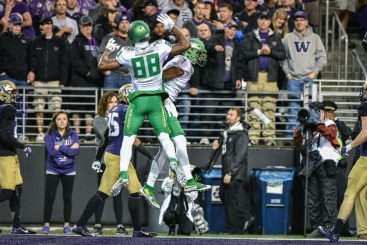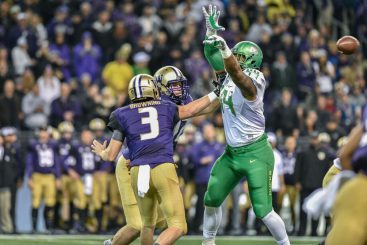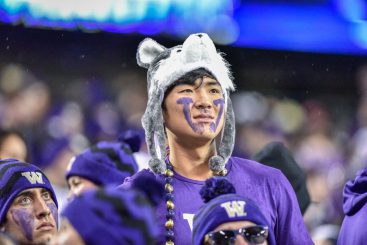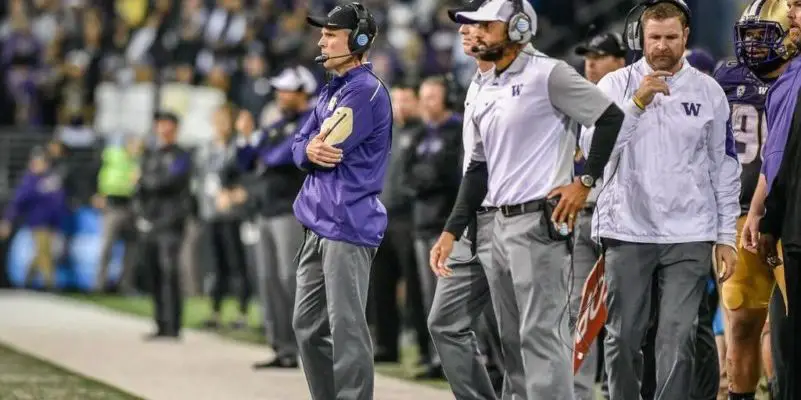Mike Merrell’s Three-and-Out
As reported by ESPN at the recent Pac-12 Media Days, Washington coach Chris Petersen turned the tables and begged the dogs — to not get their expectations up too high.
It’s not false modesty. It’s an honest assessment from the one insider who knows the Huskies best.
Petersen also knows that man’s level of satisfaction relates highly to the difference between expectations and eventual outcomes. And probably no team in college football has raised expectations as much as the Washington Huskies.
Quelling the gasoline being splattered around before the match is thrown is the first of many battles Petersen will face this season — and it’s a dandy.
Among the hype, ESPN’s Pac-12 Blog rates Washington’s trio of starting offensive skill players (one each: quarterback, running back, receiver) as second only to Washington State in the Pac-12, while labeling the Oregon Ducks a mediocre sixth.
For ESPN to even suggest that Washington’s offense is vastly superior to Oregon’s by any measurement is –I will say this as nicely as I can — highly dangerous talk for Petersen’s quest to regulate the gap between expectations and what he has to see coming.
A comparison of the Huskies’ offensive skill players to the Ducks’ – with its potential impact on Petersen’s job – is the subject of this special edition of the Three-and-Out.
1. Running Back. Washington running back Myles Gaskin had a solid freshman season in 2015, rushing 227 times for 1302 yards and a 5.7 yard per carry average. That’s not bad, but it’s over five football fields short of Oregon’s Royce Freeman, who ran for 1836 yards on an average of 6.5 yards per carry.

Royce Freeman is closing in on the career rushing record for the Pac-12’s leading rushing team.
Freeman is already what Gaskin aspires to be — a proven third-year starter closing in on a 2,000 yard year. Freeman also enjoys the advantage of having undeniably the best supporting cast in the Pac-12
Gaskin’s 5.7 yards per carry would have only been good for fifth among the Ducks’ primary group of running backs, behind Freeman, Taj Griffin (7.4), Kani Benoit (7.0) and Tony Brooks-James (9.0).
Gaskin is a solid up-an-coming running back. But you have to understand why Petersen would not want to have fans expect Washington’s running game to be better than Oregon’s.
2. Receiver. Petersen has a problem here, too. Three out of Washington’s top four receivers from 2014 have moved on. ESPN had to dig deep to find anybody who vaguely resembles a threat for the dogs. They settled on John Ross, who missed half of 2014 and all of 2015 due to two knee injuries. Before the injuries set in, Ross had a total of 33 catches for 579 yards over the 2013 and 2014 seasons.

Someone forgot to tell Duck veterans Dwayne Stanford and Darren Carrington that they’re not as good as an injury-prone Husky with 33 career catches.
You could start a phone book with Duck receivers who would start ahead of Ross — and have a better chance of making it through the season. Darren Carrington made mincemeat out of Florida State in the 2015 Rose Bowl. Dwayne Stanford has over 1200 career receiving yards. Charles Nelson is a touchdown waiting to happen every time he touches the ball. Jalen Brown’s first-year production in 2015 was limited only by playing time. And true freshman Dillon Mitchell may prove to be the most dangerous receiver on the 2016 team.
Pharaoh Brown, Johnny Mundt and Evan Baylis are probably the best trio of tight ends in the conference, if not the country. And running backs Griffin and Brooks-James are expected to line up in the slot to get more touches.
Defensive backs have to get tired just watching game film on Oregon’s receivers, let alone trying to put the hit on (or getting trucked by) Freeman and Benoit when they burst into the secondary. Then just when they’re really, really tired — out trots Devon Allen, the fastest man in college football, fresh from Rio.
A guy who has 33 career catches, a history of knee injuries and hasn’t made it through a complete season since 2013 is better than any of that?
No. Running back or receiver can’t possibly be viewed as points of Husky superiority, so if the Huskies have overall better first-line skill players than the Ducks, they must have one helluva …
3. Quarterback. Like Myles Gaskin, Washington QB Jake Browning was a freshman in 2015, so he might be quite a bit better in 2016. He needs to be if he wants to keep his coach off the hot seat.
On the surface Browning’s 16 touchdowns to 10 interceptions — while a little pedestrian — aren’t too bad for a frosh. But digging a little deeper, 13 of his touchdowns came against Sacramento State (2-9, FCS), Utah State (6-7), the Beavers, and an Arizona team that gave up over 49 points per game in six Pac-12 losses. Against the same four teams, Browning had only one interception.
Doing some second grade math here — that leaves — hmm — three touchdowns and nine interceptions against everybody else. And that’s better than first team FCS All-America?

In 2015 Husky QB Jake Browning threw three touchdowns and nine interceptions against teams not named Sacramento State, Utah State, Oregon State or Arizona.
While it’s true that Oregon’s Dakota Prukop achieved his All-American status throwing against FCS secondaries instead of those of the FBS, he also did it throwing to FCS receivers — and not top ones at that. He also did it without the threat of Freeman & Co. keeping defenses honest.
Husky fans — and presumably ESPN — will no doubt argue that Browning was highly recruited out of high school, so he obviously has the potential. Well, Prukop was highly recruited by Alabama’s Nick Saban just last winter. But what does Saban know about football, right?
Unlike Browning, Prukop has wheels. Over the past two seasons, Prukop rushed 327 times for 1,743 yards, a healthy 5.33 yards per run. Last year Browning racked up all of 35 yards on 65 carries, which is almost exactly 1 yard per carry to every 10 for Prukop. Browning also took 30 sacks, the only category where he made the cut for top 20 in FBS football. And that’s not a good thing if you like purple.
As is the case with running backs and receivers, depth is also an issue at the QB position for the Huskies. Behind Browning, the only QB with college experience is his sophomore peer K.J. Carta-Samuels, whose career stats include 10 completions for 124 yards on 24 attempts, zero touchdowns, one interception and two sacks. Oh — and minus three yards rushing.
By the time incoming frosh Justin Herbert shows up at fall camp for Oregon, Washington’s # 2 quarterback would find himself in the # 7 position with the Ducks.
To put things in perspective, here’s a list of all of the teams that failed to score at least 21 points on Oregon’s porous defense last year:
1. Washington.
Yes, that’s the entire list. No Eastern Washington. No Colorado. Not even Oregon State.
Only … the … Huskies.
And it was no accident or “early season” learning curve. As late as November 14, the 2015 Huskies scored only 17 on Arizona State.

Husky fan shows off his Kool-Aid smile.
True, Washington finished the year with a relative offensive explosion — against the Beavers, the Falk-less Cougars who couldn’t keep their offense on the field, and Conference USA’s Southern Miss. It takes a full pitcher of grape Kool-Aid to make much of that. And Chris Petersen, more than anybody else, knows it.
So Petersen has a real problem on his hands. His offense is nowhere near what fans are being led to expect — and he has to be sweating bullets thinking about what happens if one of his top skill players goes down, because there’s not much behind curtain # 2.
At least some of the hype for this year’s Huskies revolves around Petersen’s undeniable success at Boise State. Possibly overlooked is the fact that Dan Hawkins also knocked ’em dead with the Smurf Ponies before falling on his face at Colorado. And Dirk Koetter did the same before his flop at Arizona State.
And certainly overlooked is how thin the ice is at Petersen’s over-hyped offensive skill positions.
So what happens this year when the Ducks hang # 13 in a row on the dogs, and a rising Washington State takes them down on a chilly late November afternoon in Pullman? If the Huskies don’t get their expectations in check, you can hit the Yellow Pages for marriage counselors, because the honeymoon is going to be over.
And Petersen knows it.
Top photo by Kevin Cline
Related Articles:
Oregon Enters Playoffs Better Off Than Last Year
Will The Coaching Carousel Kill Oregon's CFP Chances?
The Playoff Formula Hasn't Changed
Oregon Aims to Bury Dawgs, Punch Playoff Ticket in Rivalry Clash
Huskies Are the New Beavers, Stay In Your Lane Kiffin, and the Civil Apple Cup War
Oregon Football: The X-Factor Vs. Washington
Mike (Editor-in-Chief) is a 1970 graduate of the University of Oregon where he attended the Honors College and received all-conference honors as a swimmer. After college, Mike ran for the Oregon Track Club and narrowly missed qualifying for the US Olympic Trials in the marathon. He continues his involvement in sports with near-daily swimming or running workouts, occasional masters swim competition (where he has received two Top-10 World rankings), providing volunteer coaching to local triathletes and helping out with FishDuck.com.
Mike lives on 28 acres in the forest near Sandpoint, Idaho, where he has served as a certified public accountant for most of his working career. His current night job is writing novels about Abby Westminster, the only known illegitimate daughter of Britain’s finest secret agent who has to bring down arch-villains plotting dastardly deeds. And, yes, Abby is also a DUCK!

